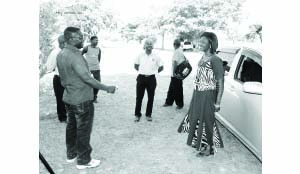By XAVIER MANCHISHI –
NEVER has the dream of living in an electrified grass-thatched hut been closer to reality than for the residents of Kazembe in Luapula Province whose households the Rural Electrification Authority (REA) is connecting to the national electricity grid.

•KUNDAMFUMU Rural Health Centre sister in-charge Dorothy Chirwa (right) talks to the REA officers and journalists.
Reality is about to dawn on more than 400 residents in Kazembe area of Mwansabombwe, whose households are earmarked for electrification under the Mununshi grid extension project in a paradigm shift from the usual lighting up of peri-urban homes.
“That is good. It will help my people to buy a television, fridge and other electrical appliances like their colleagues in urban areas,” Chief Mwata Kazembe of the Lunda people beamed at the electrification of grass-thatched houses in his chiefdom.
One bottleneck, however, awaits REA because most of the residents of Mununshi which borders vilages in Mwense District have no routine income to pay the bills once the project is up and running.
The Mwata in a parental way of speaking on behalf of his subjects also wondered what criteria would be used to pick houses to be electrified and whether those that are content with using alternative sources of energy would be spared the blushes.
But REA corporate affairs manager Justin Mukosa argues that the electrification of grass-thatched houses which was being piloted in Eastern, Luapula and North-Western provinces was tailor-made for rural set-ups that need lighting.
Mr Mukosa is of the view that since most households would be using the electricity mainly for lighting, they would accrue negligible bills and with pre-paid metres that will be installed in the houses so that clients are only asked to pay for what they use.
According to Mr Mukosa, failure to pay bills should not be reason for not connecting the villagers who could have their economic standing boosted in future by which time they will already be connected.
Under the projects being implemented in Luapula, it is not only grass-thatched huts that will benefit but also other public places such as schools, rural health centres and chiefs palaces.
One such facility is Kundamfumu Rural Health Centre where nurse-in-charge Dorothy Chirwa is working alone because other workers have shunned the centre.
“The lack of electricity is a serious challenge. Most of my colleagues do not want to be transferred here where there is no power. We can’t even store our medicine supplies,” Ms Chirwa reluctantly decried her misery.
Lack of facilities such a fridge has compounded Ms Chirwa’s misery since she has to trek to Chembe at the district medical office where her supplies are kept, using her own vehicle and fuel.
Another of Ms Chirwa’s ilk facing rural hardships is youthful Josephine Nkowane who mans Mununshi Rural Health Centre which was recently electrified by REA.
Having worked at the centre before it was connected to the national grid and after, Ms Nkowane is a living testimony of how electricity alone can lift the spirits of a community.
Mununshi Rural Health centre is still grappling with the low voltage which Mwata Kazembe also complained of. Apart from that, the area also has incessant load-shedding.
The only consolation is that through the area’s own natural resource endowment, ZESCO has embarked on a project to increase generation capacity at Musonda Falls to mitigate load-shedding and low voltage.
Other beneficiaries of the Mununshi grid extension project include Chibondo Basic School whose Head Teacher Emmanuel Kasuba said since the school was electrified by REA in 2014, it had improved the grade nine pass rate by 30 per cent.
Those sentiments were echoed by Myengele Basic School Head Teacher Victor Chanda who noted that the electrification of rural schools would help learners in Information Communication Technology (ICT) subjects under the newly introduced curriculum.
In Milenge District, Musaba primary is among three schools that REA has electrified under phase one of a project that was completed in June last year.
The project involved the construction of a 30kilometre long 33 kilovotts line from Musaila junction to Musaba primary school at a cost of K2 million.
Mulisha, Nkungu and Musaba primary schools were the beneficiaries of the Milenge grid extension project.
Oblivious to REA, the three schools are still in total darkness, no thanks to a structure that has been built under the power lines forcing Zesco Limited to delay the connection.
A recommendation has since been made to have the power lines re-routed.
Under phase two which will cost REA K7 million, Mungulube and Kafwanka primary schools as well as Kabongo and Mungulube rural health centres would be connected to the national grid by June 2015.
Kibalala, Chisakana, Kasanka primary schools will be electrified under phase three alongside Kasanka rural health centre and Senior chief Kalasa Mukoso’s palace at a cost of K8 million.
If you had asked any Mununshi villager a month ago if they ever dreamed of having electricity in their grass-thatched huts, they would take you for a nutcase. Not anymore, theirs now is a dream come true.
Their light is no longer just at the proverbial end of the tunnel but the whole hut which REA has undertaken to light up.






